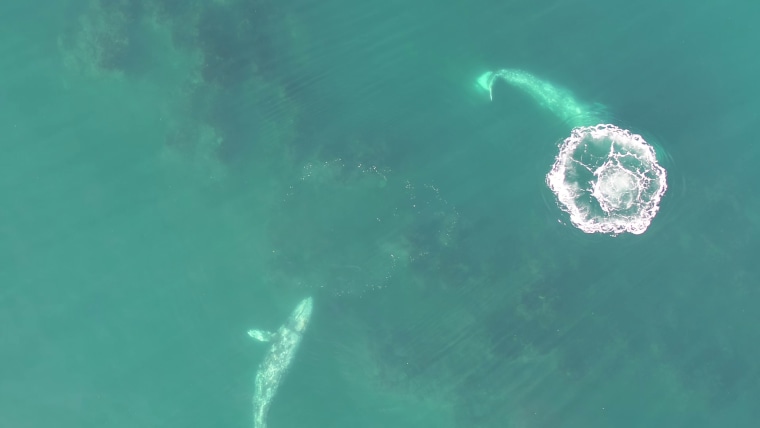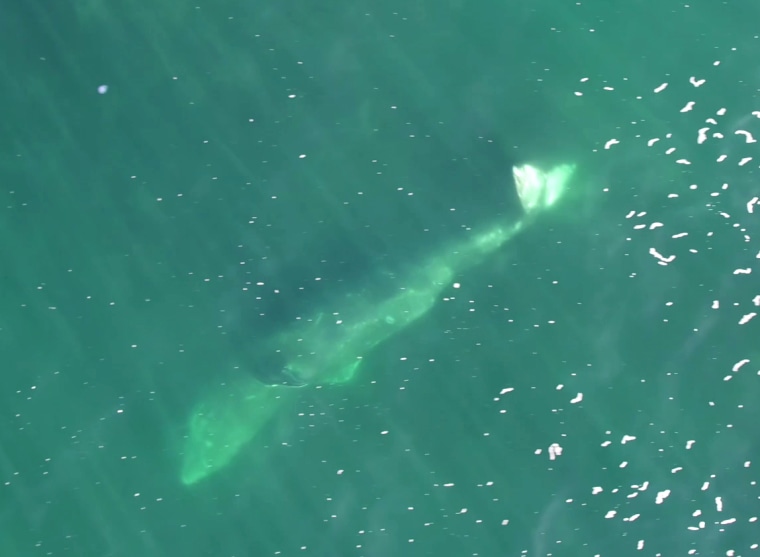Drone video of gray whales captured over seven years off Oregon has revealed new details about how the giant marine mammals find and eat food.
Among the findings, described in two studies published this summer, are that gray whales rely on different swimming techniques to gather food based on their size and age, and that larger whales are more likely to emit “bubble bursts.” ” to help them stay underwater.
“Prior to this study, we thought every whale used one of those behaviors,” said lead author of both studies, Clara Bird, a researcher at Oregon State University’s Marine Mammal Institute. “No one really thought there was a pattern to who used which behavior.”
Bird’s research also found that whales use different feeding techniques based on the depth of water in which they forage and the habitats of their prey. Such information could help future conservation efforts, she said, because it provides insight into the types of habitats that may need to be protected to maintain the whales’ access to food.
“While right now we’re not actively trying to protect specific habitats, it’s really important to know that whales of different ages may not be using the same habitat for future concerns,” Bird said. “It will help us manage them moving forward.”

A segment of the gray whale population is listed as endangered under the Endangered Species Act. The entire species once faced the risk of extinction due to commercial hunting. Once common throughout the northern hemisphere, gray whales are now regularly seen only in the North Pacific. According to a 2020 report by the National Oceanic and Atmospheric Administration, there were estimated to be fewer than 27,000 in the area as of 2016.
Whales eat amphipod crustaceans such as small shrimp and worms, which they consume by sucking up water and sediment from the sea floor where such creatures live, and then use their baleen to filter the food. Gray whales are usually seen alone or in small groups, although large groups can be seen at feeding or breeding sites.
Bird and her team conduct their research outside of Newport. On sailing trips over seven years, the group tracked and recorded individual whales via drones. They identified individual whales using distinguishing marks such as scars, spots or tail shape.
The first study resulting from that work, published in the journal Animal Behavior in July, focused on differences in whales’ foraging behavior depending on their size and habitats.
The team tracked 78 gray whales during a total of 160 sightings from 2016 to 2022. In the drone video, they noticed that the younger, smaller whales often swam sideways or face forward, opening and closing their mouths to find and to get food. Older, larger whales, meanwhile, tended to dive and then stay in place upside down in what scientists describe as a “headstand technique.”
The probability of such headstands increased as a whale got larger, the study found, while the probability of the forward swimming tactic decreased. The depth of the water and the type of habitat—rocky, sandy, or coral—also played a role in the approaches the whales took.

Bird attributes the difference between the techniques to the maturity of the whale’s muscles, as well as its levels of strength and coordination.
Her team’s second study, published in the journal Ecology and Evolution in August, described how older and larger whales release air from their vents to help them stay underwater when foraging.
“Bubble bursts” can help a whale sink by reducing its power. Larger whales have a greater need for it because their larger lungs hold more air and they have more blubber, both of which make them prone to swimming.
The discovery was based on observations of 75 whales. On average, a bubble burst came 27 seconds after a whale dove for food, and most were observed while the whales were nodding. The older and larger a whale became, the greater the probability of such an explosion.
“This kind of pairing of size with individual-level behavior is a really exciting part of this study,” Bird said.
Susan Parks, a biology professor at Syracuse University who has published studies on whale eating habits but was not involved in the new research, said documenting the diversity among a whale species helps scientists avoid generalizations. incorrect.
“As we try to do conservation efforts or conserve endangered species, it’s really important to understand that there can be a wide variation in behavior,” Parks said. “So we can’t just stop at a single observation.”
Parks also highlighted the potential of drones for collecting detailed data about whales.
“There are so many unknowns about their behavior,” she said, adding that the study shows how “using drone footage to essentially spy on what the whales are doing gave them a completely different perspective on the details of how were making a living”.